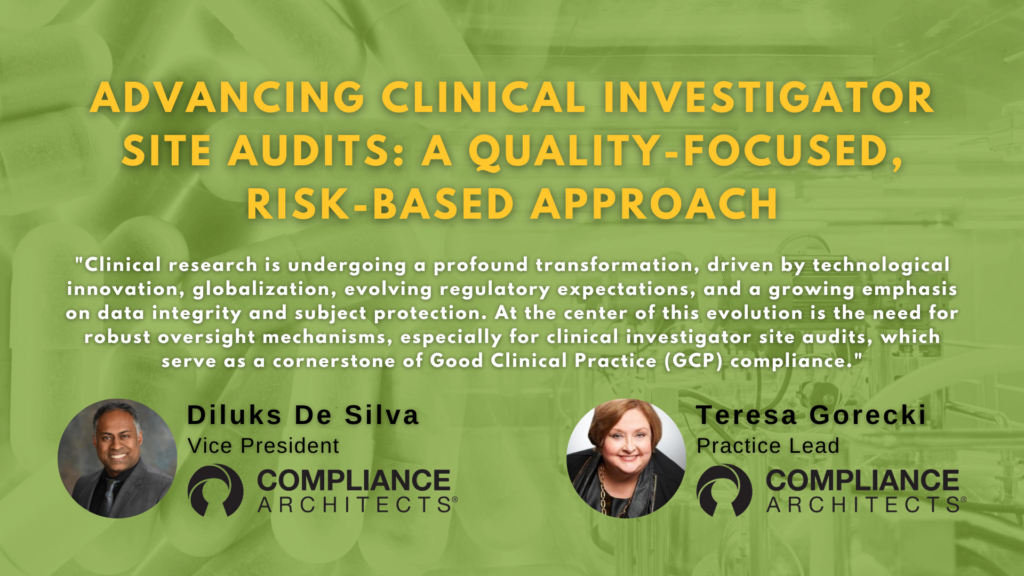Table of Contents
FDA Bioresearch Monitoring Inspection Readiness
The road to FDA approval of a new Pharmaceutical, Biological, or Medical Device is challenging for clinical study sponsors and investigator sites, one fraught with stringent regulations and critical inspections by the FDA and/or other global health authorities.
For sponsors conducting clinical trials, one of the most pivotal moments comes during FDA Bioresearch Monitoring (BIMO) Inspections of the sponsor, CRO(s), investigator sites, and potentially the IRB(s). These inspections are conducted to assess study data integrity, compliance with regulations and applicable standards, and the safety of trial participants.
A lack of readiness for such inspections can and has resulted in delays, costly corrections, or worse, jeopardized product submission timelines and, ultimately, new product approvals.
But inspection readiness isn’t just about organizing paperwork just prior to the FDA BIMO Inspection and hoping for the best. It requires a strategic and proactive approach that integrates accountability at every step.
It requires conducting the clinical study and IRB oversight from beginning to end, knowing all of the work completed will potentially be audited by the FDA and/or other global health authorities. To paraphrase Steven Covey, you must “begin and conduct each trial with the end in mind.”
The Importance of BIMO Inspections
The FDA’s BIMO program monitors clinical trials to safeguard participants’ welfare and ensure the accuracy of the submitted data. These inspections can occur at any stage of a clinical study—for cause, at the study’s conclusion, or during the agency’s review of a marketing application.
Failure to meet FDA regulations during these inspections will likely result in a Form 483, detailing deficiencies that require resolution. If the findings are not adequately addressed, sponsors risk receiving a Warning Letter from the FDA. The consequences of receiving an FDA Warning Letter are significant and, if not remediated in an adequate and timely manner, can include the following:
Sponsor Impact -Products pending approval under an NDA, BLA, or PMA under an active Warning Letter issued to the sponsor will not be approved until the Warning Letter is fully resolved. Sponsors cannot risk significant FDA BIMO Inspection outcomes resulting in a Warning Letter.
Investigator or Laboratory Impact – Questionable data generated by an investigator or laboratory may become “invalid”. In this case, these data may not be included in the clinical study report(s) included in the pending sponsor’s NDA, BLA, or PMA submission to the FDA. If the study report requires significant revision if additional studies are needed to achieve the endpoints in the study due to the invalidation of substantive data, the marketing application timeline can be impacted.
IRB Impact – The IRB can be partially or fully restricted until the Warning Letter is fully resolved if significant compliance gaps are documented by the FDA during an FDA BIMO Inspection of the IRB of Record for the clinical study.
Common Challenges in BIMO Compliance
Getting clinical studies inspection-ready is fraught with challenges. Identifying these early on can significantly improve outcomes. Some frequent deficiencies during inspections include:
For Investigators and Sites
- Protocol deviations and failure to follow investigational plans.
- Poor recordkeeping and informed consent processes.
- Mismanagement of investigational products.
For Sponsors, CROs, and Monitors
- Insufficient monitoring of clinical sites
- Failing to bring investigators into compliance
- Lack of FDA or IRB approval prior to initiating a study
Each of these challenges underscores the need for rigorous planning and accountability across all stakeholders.
For IRBs
- Meeting minutes
Establishing a Readiness Framework for Sponsors
Achieving inspection readiness is not a one-time task; it is an ongoing effort requiring coordination across personnel, systems, and processes. Here are the foundational steps for BIMO preparedness.
1. Strong Documentation Management
Documentation is the backbone of FDA inspections. Sponsors must ensure that study files, both theirs and those of their sites, are audit-ready at all times. A fragmented or inadequate documentation system will only complicate inspections further and invite scrutiny.
Recommendations:
- Implement a centralized, 21 CFR Part 11–compliant electronic trial master file system (eTMF). Paper-based systems are rarely fully compliant due to their nature (i.e. paper-based).
- Conduct regular internal audits to validate that required documents are updated and correctly filed.
Investing in organized and comprehensive documentation preemptively will save time and mitigate chaos when the FDA requests access during inspection. It can be impossible to “re-create” a Trial Master File when the study is completed, just prior to an FDA BIMO Inspection.
2. Effective Standard Operating Procedures (SOPs)

Your SOPs serve as a blueprint for maintaining compliance and consistency across studies. However, overly rigid or neglected SOPs can be equally damaging as vague processes. Sponsors need dynamic SOPs that comply with regulatory requirements while allowing for practical workflow adaptations.
Recommendations:
- Design SOPs collaboratively with input from compliance experts and operational teams.
- Train staff on updated SOPs regularly, ensuring consistency across global teams for multi-regional studies.
- Use team feedback to refine and enhance your SOPs continuously.
3. Monitor Study Operations Diligently
Monitoring is essential for ensuring all key stakeholders, from investigators to CROs, maintain compliance and integrity in their processes. These operations must be rigorously reviewed for both adherence to plans and the protection of trial participants.
Recommendations:
- Schedule regular on-site and remote monitoring visits to assess compliance.
- Deploy detailed checklists and real-time tracking tools to evaluate study protocol adherence.
- Arrange training sessions to ensure site personnel are equipped for FDA standards.
4. Train Teams for FDA Inspections
Inspection-day anxiety is a universal challenge. Preparedness is therefore pivotal in ensuring teams understand how to answer FDA inquiries, locate required documents, and effectively convey their compliance efforts.
Recommendations:
- Conduct mock BIMO inspections to familiarize staff with real-world scenarios.
- Simulate challenging situations through role-playing exercises, particularly for FDA questioning.
- Provide a detailed guide of roles expected during the inspection process.
Hands-on reinforcement goes a long way in reducing stress and improving performance when inspection day finally arrives.
5. Simulate Real Inspections with Mock Audits
Mock audits remain one of the most effective tools for preparing clinical teams to meet FDA expectations. These mock inspections highlight potential vulnerabilities while serving as invaluable training for site staff.
Recommendations:
- Perform a mock BIMO inspection at least six months prior to submitting applications such as INDs or NDAs.
- Use findings from the audit to address documentation gaps and refine operational processes.
- Ensure cross-functional teams participate, fostering a collective culture of compliance and readiness.
Mock audits are more than a rehearsal; they provide your teams with a practical roadmap for achieving consistent adherence to BIMO standards.
6. Collaborate and Seek Expert Support
Effective partnerships can make all the difference in achieving FDA inspection readiness, especially for organizations new to complex clinical trials.
Experienced consultants and CROs serve as valuable resources in facilitating process optimization, fostering compliance, and conducting thorough mock inspections.
Recommendations:
- Engage with consulting firms specializing in FDA inspection preparation and guidance.
- Use external resources to train staff, audit processes, and identify potential red flags.
- Build long-term partnerships to ensure sustained compliance across evolving clinical programs.
Having an outside perspective can help uncover blind spots within your operations, further ensuring no aspect of compliance is overlooked.
Achieving Inspection-Day Success
From robust monitoring to centralized documentation, achieving BIMO readiness demands dedication, clear planning, and a proactive mindset. Here are some final tips for an optimal FDA inspection experience.
Preparation: Ensure your documentation is error-free, your staff is trained, and your facilities are ready to welcome the inspector.
Transparency: Keep communication open and clear with inspectors, and always report findings truthfully.
Professionalism: Maintain a welcoming and respectful demeanor towards inspectors throughout the process.
The Competitive Advantage of Inspection Readiness
BIMO inspections are not just regulatory requirements; they represent an opportunity to demonstrate your integrity, efficiency, and commitment to clinical excellence to the FDA and other stakeholders.
By fostering a state of perpetual readiness, you significantly increase your odds of clinical success while establishing trust within the industry.
For sponsors wishing to enhance their preparedness, collaborating with clinical research consulting firms offers an effective path forward.
With proven strategies and tailored solutions, the hurdles of FDA BIMO inspections become manageable stepping stones toward product approval.
Reach out to learn how mock audits and inspection readiness solutions can streamline success for your team.





